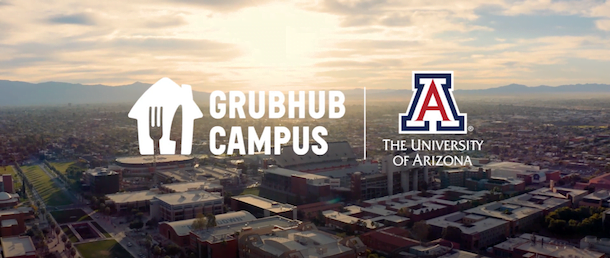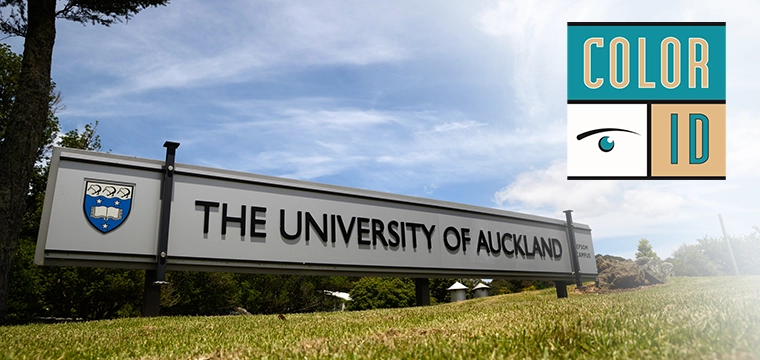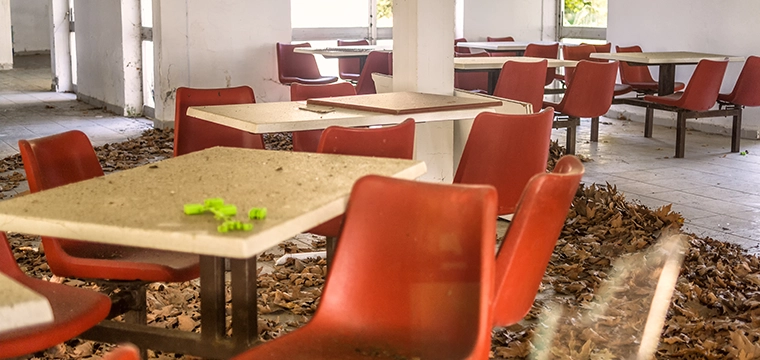
The trend in university dining services is undeniably one toward technology, with mobile ordering, delivery robots, pick-up lockers and self-service kiosks all playing a role in redefining the way campuses provide food to hungry students.
One of the most technology-driven dining experiences could be that of the University of Arizona, where all of these solutions – and a couple new ones – have been deployed.
In a recent webinar with Grubhub and CampusIDNews, Christine Carlson, the Director of Dining & Nutrition at the University of Arizona, detailed the dining environment on campus. Arizona is using a combination of mobile ordering through partner Grubhub, along with campus delivery, smart lockers, self-service kiosks and more.
Arizona Dining is self-op, with some 30+ dining locations across campus. Those locations span the university’s all-you-care-to-eat meal plans, a la carte dining, café locations and c-store options. In all, Arizona serves roughly 7,800 residential students and a full-time enrollment of over 43,000.
The prospect of running an efficient dining services operation in a pandemic – and the many challenges that come with – led Arizona to seek out new ways of providing food for hungry Wildcats. The university began to look at how technology could help to alleviate pain points and redistribute labor.
“One of the big constraints, and one that everyone else is feeling, is staffing,” says Carlson. “Minimum wage going up, coupled with staff shortages, has been a big challenge for us.”
Another concern for Arizona over the past two years, as at other campuses, was hygiene. “Some of the technology additions have helped us to provide safer, contactless dining experiences on campus during the pandemic,” says Carlson.
In addition to offering a wider selection of food choices, Arizona wanted to increase the use of dining services by upperclassmen, and better utilize its limited facilities. “We did this by focusing on solutions that could help us increase throughput without adding locations,” says Carlson.
Arizona was an early adopter of mobile ordering and has a longstanding partnership with Grubhub. Over time, that partnership has helped to integrate self-service kiosks along with delivery through couriers staffed by Grubhub.
Arizona has also leaned on Grubhub to help acclimate new students to campus life. When a student opens the Grubhub app at Arizona, they’re shown only the locations on campus, as opposed to a lengthy list of locations across the surrounding areas.
Different campuses have very different needs. Our job as a technology provider is to provide enough solutions so that we can find the ones that fit best for the university.
- Ben Anderson, Grubhub
“For freshmen or incoming students, I liken it to being from out of town, you’re in the grocery store for the first time and you have no idea where the black beans are,” says Carlson. “But if you go to the store ten times, then you have a better idea of which aisle to look in.”
When it comes to delivery, it’s a campus-by-campus discussion as to the best avenues to provide efficient on-campus delivery.
“Different campuses have very different needs,” says Ben Anderson, Director of Campus Partnerships at Grubhub. “At the end of the day our job, as a technology provider, is to provide enough solutions so that we can find the ones that fit best for the university.”
Another benefit of the kiosks is that they’ve boosted order values. “If you’ve visited it before, the kiosk remembers what you’ve previously ordered,” says Carlson. “More importantly, the kiosk always remembers to upsell – add chips and a soda – which is amazing.”
Adding to the customer experience, the kiosks also inform students when the order will be ready, and monitors have been installed that show where the student is in the queue.
“From an operational perspective, the kiosks enable us to redistribute the cashier to a different efficiency in that dining location,” says Carlson. “Labor previously devoted to cashiering can now be on food prep, expediting, or order fulfillment.”
Another technology added to Arizona’s dining environment is a smart locker system that supports order pickup.
“We were looking at pickup lockers pre-COVID, but the pandemic sped up the deployment process,” says Carlson. “We went with Apex lockers specifically because they were integrated with Grubhub already, and we wanted to make things as seamless as possible for our students.”
To place an order for locker pickup, students select that they want to pickup at a specific location and are informed which bank of lockers to visit. The student then scans the barcode included with the order, and the locker lights up and opens.
Arizona has set a dwell time on each order to ensure freshness. The lockers are ambient and insulated to maintain the freshness of the order while it waits to be retrieved.
“Lockers offer an opportunity to create a sort of ‘branch pick up’ environment,” says Grubhub’s Anderson. “It opens the possibility for a remote location to have food without all the infrastructure of a traditional dining location.”
It used to be that the POS was where the waiting happened. But as we’ve implemented mobile, the bottleneck is now the point of pickup. It’s a great use case for smart lockers because it helps to better regulate and organize the pick-up experience.
- Ben Anderson, Grubhub
“It used to be that the POS was where the waiting happened. But as we’ve implemented mobile, the bottleneck is now the point of pickup,” adds Anderson. “It’s a great use case for smart lockers, as an example, because it helps to better regulate and organize the pick up experience.”
Dining locations can come at a premium on a college campus, and with such a large population to serve, demand for more food options is ever present. It’s a challenge that Carlson has faced on campus at Arizona.
“Every building seems to want a café, and that got us thinking of how we could provide food without having to put a shop and labor there,” explains Carlson. “We have one building on campus where all we’re doing is running food to that location using lockers for pick up. It’s working quite well.”
The smart lockers have also enabled Arizona to open ghost kitchens in other areas of campus.
“We have ghost kitchens in locations where we have a full kitchen, but not the labor force to run the traditional restaurant aspect,” explains Carlson. “So we run the kitchen in those locations and use lockers as the means to provide the orders to students.”
Carlson points to an example this past semester of a Mexican restaurant that ran out of a buffet but utilized locker pickup. “The value there is that students can pick up a full meal, albeit without the sit-down element, but it’s helped us to maintain the same level of variety in dining despite our limited staff.”
Arizona has gone one step further in its technology deployments, adding vending machines that prepare entire meals for the buyer. These smart vending machines have added yet more efficiency in UA dining.
“We’ve added Sally the Salad Making Robots, Kellogg’s Bowl Bot, Yokai Ramen Machine, and Costa Coffee Machines,” says Carlson. “These machines are great because we load them with fresh food, and then we don’t have to have the labor standing there waiting for the customer to come.”
These machines are great because we load them with fresh food, and they don’t require the physical labor of standing there waiting for the customer to come.
- Christine Carlson, University of Arizona
The smart vending machines haven’t just operated smoothly, they’ve also provided the option of fresh, customizable food at different times of the day across campus.
“Students can now get a salad in the morning for lunch,” says Carlson. “It’s ideal for students who know they don’t have time in the middle of the day to get a meal.”
Carlson says it’s also interesting to watch the different day parts that each machine is utilized. Late-night fare on a college campus has traditionally been a difficult nut to crack, as fresh food options, in particular, tend to dwindle after a certain hour.
“The Kellogg’s Bowl bot is used the most after midnight,” she says. “You’d expect peak times to be in the morning, but students are utilizing the machine for late-night cereal orders.”
Delivery robots have also been a massive hit on Arizona’s campus, proving to be more than just a fad.
“We started the rovers in late November, starting slow and phasing them in,” says Carlson. “By the end of the pilot we were up to 40 robots.”
The day before the pilot ended, we had our largest daily volume. We had hundreds of orders per day.
- Christine Carlson, University of Arizona
The number of orders that Arizona dining was processing through robot delivery speaks for itself.
“The day before the pilot ended, we had our largest daily volume,” says Carlson. “We had hundreds of orders per day.”
The interest in robot delivery from Grubhub hasn’t waned either.
“There’s always been this trend line in campus dining between day-part optimization and leveraging technology where you can,” says Anderson. “I think if anything delivery robots are a natural add on to that.”
With so much discussion around cutting-edge technology, it can be easy to overlook the role of the campus card. But Carlson is adamant that not only is the campus card a core component to dining at Arizona, it’s also a requisite.
“Our CatCard has to work with all technologies that we bring into campus,” she says. “I’ve said it many times, but these technologies are basically just boxes that light up if they don’t have card reader capability. It just doesn’t work without the student ID.”
I’ve said it many times, but these technologies are basically just boxes that light up if they don’t have card reader capability. It just doesn’t work without the student ID.
- Christine Carlson, University of Arizona
As is the case at many institutions, most students at Arizona either have a meal plan or they have some type of funds loaded on their CatCard. So whether it’s traditional dining hall access, or placing an order from Sally the Salad Making Robot, the campus card is involved.
“We always want to reinforce that the card is useful and branding our CatCard as something that works with any food on campus is vital,” says Carlson. “Students never have to wonder if their CatCard will be accepted at a dining concept on campus; it will always work.”
Ultimately, Arizona leaned into the use of technology to bring its campus dining experience to a new level. It’s a new way of conducting dining business that poses new challenges.
“Changing the dining business has ramifications. If you’re standing in front of a traditional cashier and a POS, you have some idea of how long you have to wait for your order,” says Anderson. “But as technology has enabled people to order from their dorms or on their way to class, it’s the transparency that has really become good service.”
In this new formula for campus dining with mobile ordering and other intuitive, self-service elements, customer service really hinges on keeping customers informed. Updating them to know how long the process is going to take so that they can plan their day accordingly.
“It’s become vital to give people a crystal-clear view of what their ETA’s are, how long it’s going to take, where they are in a virtual line,” explains Anderson. “We’ve found these things to be crucial to the puzzle now because you don’t want to feel like you’re just beaming your order out into the virtual abyss.”
Anytime we add a technology we ask if we’re offering a solution for students that adds convenience, or if it's just a cool trending thing they’re interested in right now. We want to know that we’re solving for a pain point in our operations.
- Christine Carlson, University of Arizona
For Carlson and Arizona new technology is exciting, but for it to make a meaningful difference, it needs to be implemented thoughtfully.
“Anytime we add a technology we ask if we’re offering a solution for students that adds convenience or just something that’s kind of a cool trending thing they’re interested in right now,” says Carlson. “We want to know that we’re solving for a pain point in our operations."
To learn more about partnering with Grubhub, visit onsite.grubhub.com.




